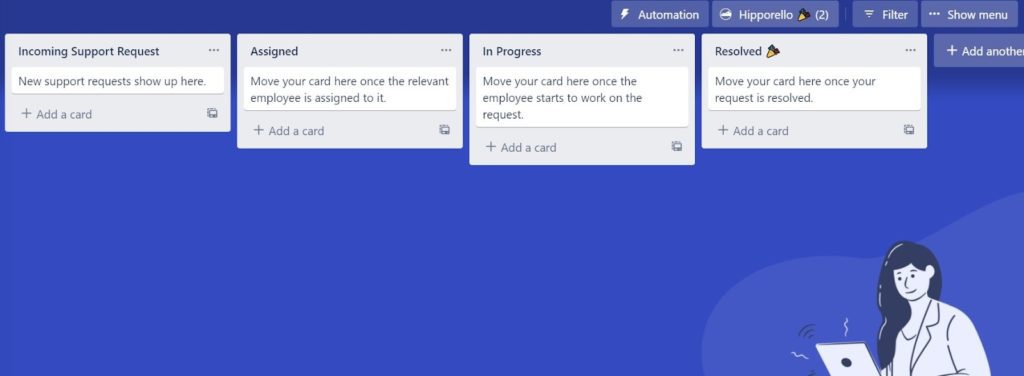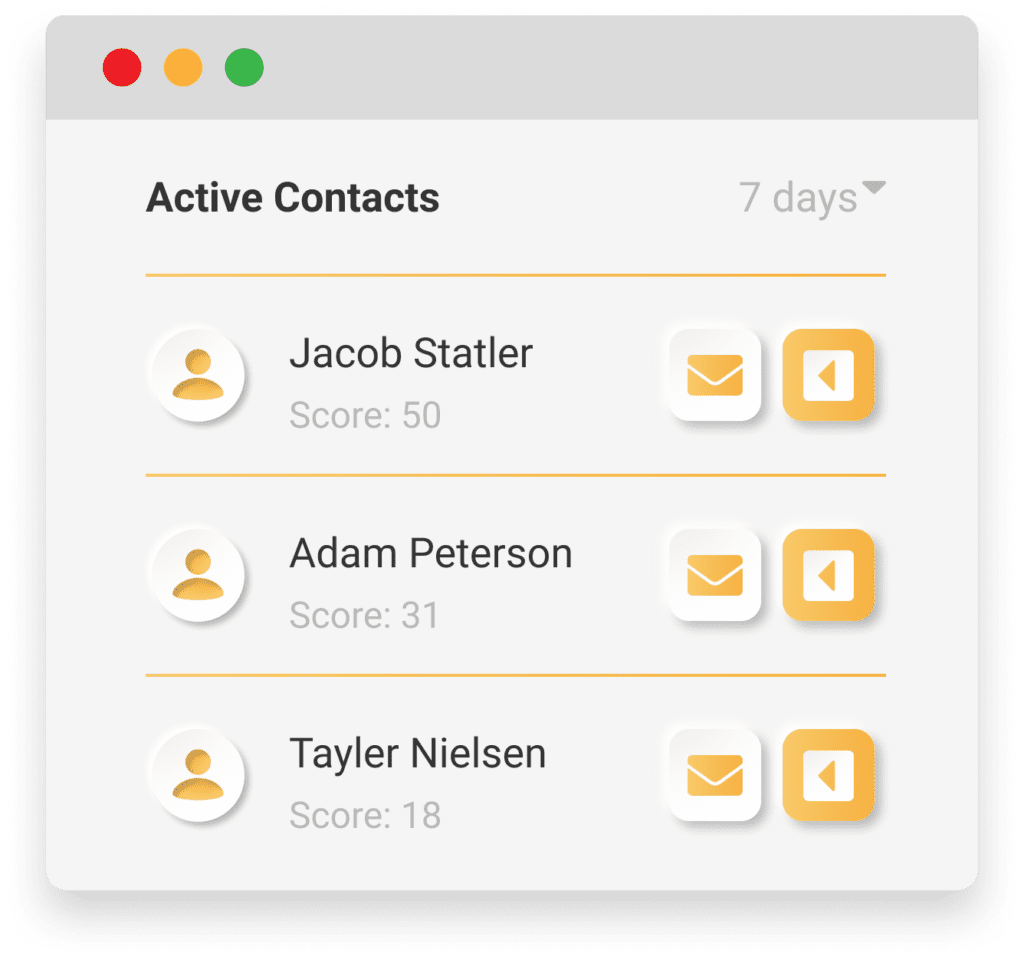Last updated on August 3rd, 2023

This guide will help you understand whether you should use Trello as a CRM or if you’re better off investing in a designated CRM.
Many consider Trello as simply a project management app.
But with its customization options, different board capabilities, and automation assets, some choose to use Trello as a CRM.
Trello is great for project management, and using it as a CRM is undoubtedly better than nothing.
However, it’s not a complete CRM and lacks key features that an all-in-one CRM like VipeCloud would have.
You’ll learn:
- What Is Trello & Can It Be Used As A CRM?
- Can I use Trello For My Sales Pipeline?
- What Are The Pros & Cons Of Trello CRM?
- How Do I Create A CRM In Trello?
- How Does Trello CRM Compare To VipeCloud’s CRM?
- Final Takeaways Of Using Trello As A CRM

VipeCloud is the only Automation tool your small business needs to
be the hero to your customers.
With Email, Texting, Social, Suites, Chat, Stories, Video Email & Sign Up Forms fully built-in, we provide you with the perfect platform to grow your business.
15 Day Free Trial – Get started risk free. No CC needed.
What Is Trello & Can It Be Used As A CRM?
Trello is a drag-and-drop software with 1 million monthly active users.
It lets you effectively manage team projects and customize management boards to your liking and taste. Boards are where you can create and track your project milestones.
This customizable user interface is what helps Trello set the standard as a leading project management tool for many types of businesses.
Its versatility leads to many users putting it to various uses, oftenly as a “CRM.”
Trello offers marketing, and sales templates to give you a starting point to create pipelines and manage customers.

However, just because it has some CRM functions, does not make it comparable to a designated CRM (we’ll explain below).
Can I use Trello For My Sales Pipeline?
Yes, Trello can be used as a sales pipeline.
This is one of the reasons why many might mistake Trello as a CRM.
Trello’s “List” feature allows users to create lists based on sales process stages and drag deals to the appropriate category.
It could look something like this:

CRM software should have sales pipeline capabilities.
BUT this itself, does NOT make Trello a CRM.
What Are The Pros & Cons Of Trello CRM?
As you can see, Trello has some CRM-related functionality to offer, but let’s get into the full picture of Trello.
Where can it excel for your business, and where does it fall a bit short for CRM?
Pros of Using Trello As A CRM
- Flexibility – Trello offers a plethora of customization options, which gives you more leeway to gain more CRM functions (keep in mind, this adds complexity too).
- Ease of use – Using Trello as a basic sales pipeline is fairly straightforward.
- Inexpensive (before adding extra integrations) – Trello allows you to create 10 free boards and after that starts at $5 per user, up to $17.50 per user
- Easy team project management – Trello makes team projects easier for tracking, managing, and collaborating in a very intuitive way.
Cons Of Using Trello As A CRM
- Lack of contact management – Trello lacks contact management functionality, which is a core CRM feature. This means you won’t have a single source of truth for contact data. Want to quickly look up who a phone number belongs to or every contact with the status of “In Touch”? You’ll need a CRM like VipeCloud. Also, VipeCloud can automatically track your email history with a contact and log other communications.
- Doesn’t scale as well – If you’re only managing a handful of contacts and don’t plan on growing, a Trello CRM will probably get you by. However, if you plan on growing, you’ll experience the cons on this list exponetially as your contact list and company grow.
- Limited marketing features – Even with the integrations, Trello still lacks key CRM features. Things like social sharing (Trello is limited to Twitter), sign up forms, and email marketing features are significant CRM features that Trello lacks.
- Lack of data management – Without adding more integrations manually, Trello doesn’t have a way to directly manage and segment customer data, which is a key aspect of CRM.
- Lack of sales and marketing analytics – There isn’t too much data-driven reporting at your fingertips without adding integrations. Data is crucial because it helps you make accurate decisions that can impact all parts of your business.
- Less Integrative capabilities than most CRMs – CRMs like VipeCloud are built for businesses and offer more integration capabilities without having to learn and download additional apps. Calendars, reports, and form builders are a few of the essential features businesses need from the beginning.
- Trello sales pipelines aren’t comparable to a real CRM – Sure you can use Trello as a sales pipeline, but a CRM like VipeCloud is configured FOR sales from the jump.
How Do I Create A CRM In Trello?
If you’d like to try using Trello as a limited CRM, here’s how you can do it.
1. Create A Trello Account
To begin using Trello, you first have to create a free account.
Once inside, you get a bird’s eye view of your board’s menu, your workspaces, and templates on the sidebar.
2. Think About Your Board
Before diving into creating your board, think about what you want it to be.
Along with that, what will be the different stages (lists) of your board?
For example, a B2B marketing agency using it as a sales pipeline might have a setup like this:
- New leads
- Meetings booked
- Discovery complete
- Moving to proposal
- Pending deals
- Contract signed
- Invoice sent
- Onboarding
- Deals lost
- Leads to follow up with
Once you have the concept of your board outlined, you can begin creating it.
3. Build Your Trello Board
1. To create a board from your Trello dashboard, click “create” on the top bar, then click “Create Board.”
2. You’ll then be asked to give your board a name (Trello lets you create up to 10 free boards)
3. Add your lists (The different categories of your board) by clicking “Add a list”, you can drag these lists in any order. If you’re creating a sales pipeline, these will be the different stages of your sales process.

4. Create your Trello cards. These will be under different list categories, and they allow you to add information, like a description, file attachments, due dates, and even checklists.
Some of the features with cards will be better suited for project management tasks (ex., checklists), while others can help with CRM capabilities. For instance, you can set a due date on your sales pipeline to remind your sales rep to follow up with a lead.

Cards also allow you to leave comments, which is a great way to communicate internally with your team (make sure everyone has Trello email notifications.)
4. Add Your Team Members
Trello allows you to invite team members to contribute to your board.
You can do this by opening up your board and selecting “invite.”
You’ll be asked to invite them via email or a shared link.
5. Use Trello Apps & Integrations
Trello allows you to leverage apps and third-party integrations to bring more CRM capabilities to your Trello boards.
This can help make Trello more of a “CRM.” However, keep in mind, this will enlarge your tech stack, add complications, and can make your once “free” Trello CRM into one that will cost much more (depending on your integrations).
Apps and integrations on Trello are known as “Power-ups” and can help serve your different business needs.
Here’s a list of Trello power-ups to consider, if you choose to turn your Trello into a CRM:
- Lead Migration – Bring leads from another platform like Zapier, TypeForm, and Google forms, onto your Trello cards.
- Contalist – This automation helps you manage contacts to communicate with them more effectively.
- Slack integration – Share cards, set reminders, and assign board-specific Slack channels (great for the different departments of your business)
- Calendar – This Power-up adds a customizable calendar. A button will appear at the top of your Trello board.
- Gmail – Connect your boards to your Gmail account to boost productivity.
- Google Drive – You can add your Google Drive files to your Trello cards while being on the Trello platform.
These are just some of the numerous add-ons you can have with Trello.
If you go this route, think about the specific things you need out of customer relationship management and think of ways to use Trello to tailor your experience.
How Does Trello CRM CompareTo VipeCloud’s CRM?

For starters, Trello is great for internal tasks your team needs to accomplish and can work as a sales pipeline.
VipeCloud, on the other hand, goes deeper, offering internal team communication along with critical sales metrics and sales tools.
The six cons of using Trello for a CRM are ALL covered with VipeCloud.
VipeCloud is a CRM made for sales teams.

Using Trello as a CRM means you’re missing out on vital CRM capabilities like:
- Contact Scoring – Helps you pinpoint your best prospects through a scoring system so you can spend more time on them.
- Detailed Contact Information Capabilities – Store the most critical and up-to-date information on your leads and customers so you can follow up with, segment, and sell them effectively.
- CPQ System – Trackable pricing quotes you can send to your customers after getting a verbal or contractual close.
VipeCloud offers a broader range of tools that holistically serve your business (marketing, sales, and customer service). On the other hand, Trello heavily focuses on team collaboration and might miss the vital external tools that drive business growth.
Some might use it as a CRM, but remember that there are different levels of capabilities in the world of CRM.
Trello offers a straightforward UI which is especially great for project tasks.
But if you’re looking for a CRM tailored for businesses (especially in the small to the medium-size range), VipeCloud’s capabilities will give you more bang for your buck.
Final Takeaways Of Using Trello As A CRM
Trello can be customized to fit some specific CRM needs of your business, and the integrations can make the experience better.
However, it may lack things that holistically keep your business pillars simple, including complete marketing, sales, and customer service management tools.
If you’re looking for a CRM that’s simple to use AND gives you more business growth advantages, VipeCloud is your answer.
VipeCloud’s Sales & Marketing Suite offers built-in tools like sign-up forms, SMS marketing, calendars, task management, and even third-party integrations.
As your business grows and your needs change, VipeCloud CRM grows with you.
Try VipeCloud’s Sales & Marketing Suite free for 15 days.
If you have questions, feel free to book a demo call with us.

Leave a Reply